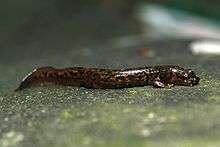Clawed salamander
The genus Onychodactylus, commonly known as clawed salamanders, is composed of three species, all endemic to eastern Asia. O. fischeri is found on the Korean peninsula, as well as in the Russian Far East and adjacent regions of China. O. japonicus is found in Japan, on the islands of Shikoku and Honshū. All species are lungless with moderately developed parotoid glands. They inhabit moist, forested mountains near small rivers, streams, and lakes. Adults of each species can reach a length of 19 cm.
| Clawed salamanders | |
|---|---|
 | |
| Onychodactylus fischeri | |
| Scientific classification | |
| Kingdom: | Animalia |
| Phylum: | Chordata |
| Class: | Amphibia |
| Order: | Urodela |
| Family: | Hynobiidae |
| Subfamily: | Onychodactylinae |
| Genus: | Onychodactylus Tscudi, 1838 |
| Species | |
|
See table | |
Species
Species recognized as of October 2019:[1]
- Onychodactylus fischeri (Boulenger, 1886)
- Onychodactylus fuscus Yoshikawa and Matsui, 2014
- Onychodactylus intermedius Nishikawa and Matsui, 2014
- Onychodactylus japonicus (Houttuyn, 1782)
- Onychodactylus kinneburi Yoshikawa, Matsui, Tanabe, and Okayama, 2013
- Onychodactylus koreanus Min, Poyarkov, and Vieites, 2012
- Onychodactylus nipponoborealis Kuro-o, Poyarkov, and Vieites, 2012
- Onychodactylus tsukubaensis Yoshikawa and Matsui, 2013
- Onychodactylus zhangyapingi Che, Poyarkov, and Yan, 2012
- Onychodactylus zhaoermii Che, Poyarkov, and Yan, 2012
gollark: I assumed they liked highly imperative programming.
gollark: That's where you write programs which work, instead of not working.
gollark: Functional programming, presumably.
gollark: And where'd EEWO go?
gollark: No.
References
- Frost, Darrel R. (2019). "Onychodactylus". Amphibian Species of the World: an Online Reference. Version 6.0. American Museum of Natural History, New York, USA. Retrieved 8 October 2019.
External links
- AmphibiaWeb: Information on amphibian declines, conservation, natural history, and taxonomy. [web application]. 2010. Berkeley, California: Onychodactylus. AmphibiaWeb, available at http://amphibiaweb.org/. (Accessed: November 20, 2010).
This article is issued from Wikipedia. The text is licensed under Creative Commons - Attribution - Sharealike. Additional terms may apply for the media files.